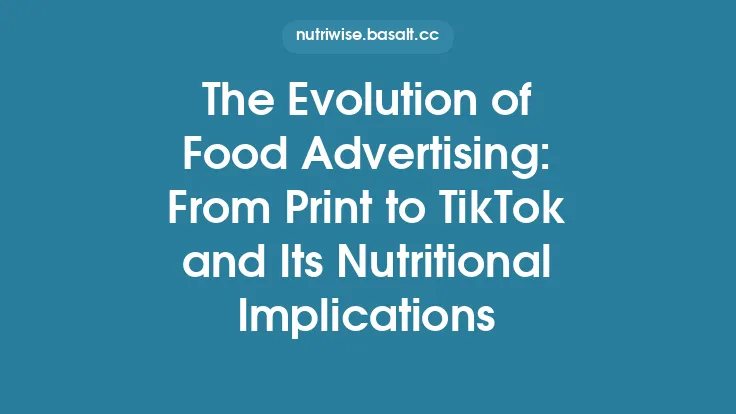Ultra‑processed foods (UPFs) have become a dominant component of modern diets worldwide, accounting for a substantial share of daily caloric intake in many populations. Defined by the extent and purpose of industrial formulation—often involving multiple processing steps, the addition of cosmetic additives, and the creation of products that are ready-to‑eat or ready‑to‑heat—UPFs differ fundamentally from minimally processed or whole foods in their composition, structure, and interaction with the gastrointestinal (GI) tract. Understanding how these foods influence digestion is essential for nutrition professionals, food scientists, and health‑conscious consumers alike.
What Makes a Food “Ultra‑Processed”?
The NOVA classification system, widely used in nutrition research, categorizes foods into four groups based on the nature, extent, and purpose of processing. Ultra‑processed foods fall into Group 4 and typically exhibit the following characteristics:
- Multiple industrial processes – extrusion, hydrolysis, pre‑gelatinization, and other techniques that transform raw ingredients into novel food matrices.
- Formulation with non‑nutritive additives – emulsifiers, flavor enhancers, sweeteners, colorants, and preservatives that are rarely used in home cooking.
- Highly refined macronutrients – isolated starches, refined sugars, and protein isolates that lack the structural complexity of whole foods.
- Convenient, hyper‑palatable formats – ready‑to‑eat meals, snack bars, sugary beverages, and reconstituted meat analogues.
These attributes collectively shape the way UPFs are broken down, absorbed, and metabolized in the digestive system.
Structural Alterations and Their Digestive Consequences
1. Disruption of Natural Food Matrices
Whole foods present nutrients within intact cellular structures (e.g., plant cell walls, muscle fibers). The mechanical and chemical breakdown of these matrices during mastication and gastric digestion releases nutrients gradually, allowing for a more controlled absorption profile.
Ultra‑processing often disintegrates or replaces these natural matrices:
- Extrusion and pre‑gelatinization convert starch granules into amorphous, highly soluble forms that are rapidly hydrolyzed by α‑amylase.
- Protein hydrolysis yields low‑molecular‑weight peptides and free amino acids that bypass the need for extensive gastric proteolysis.
The net effect is a faster gastric emptying rate and a sharper post‑prandial glucose and amino‑acid spike, which can stress insulin regulation and satiety signaling.
2. Altered Fiber Architecture
Dietary fiber in whole foods exists as a mixture of soluble (e.g., pectin, β‑glucan) and insoluble (e.g., cellulose, lignin) components, often bound within the plant cell wall. Ultra‑processing can:
- Remove or heavily reduce fiber content through refining.
- Transform soluble fibers into low‑viscosity, highly fermentable oligosaccharides that are rapidly metabolized by colonic bacteria.
While some soluble fibers can be beneficial for short‑chain fatty acid (SCFA) production, the loss of insoluble fiber diminishes bulking effects, reduces fecal transit time, and may contribute to constipation.
3. Emulsifier and Additive Interactions
Although the article avoids a deep dive into additives, it is worth noting that certain emulsifiers (e.g., polysorbate 80, carboxymethylcellulose) commonly used in UPFs can alter the mucosal barrier and modulate gut microbiota composition. These changes can indirectly affect nutrient absorption and immune responses in the gut.
Enzymatic Accessibility and Kinetics
Rapid Starch Hydrolysis
- Gelatinized starches in UPFs have a higher surface area and lack the crystalline structure that resists enzymatic attack. Consequently, pancreatic α‑amylase and brush‑border maltase act more efficiently, leading to a high glycemic index (GI).
- Resistant starch (RS), which normally escapes small‑intestinal digestion and ferments in the colon, is largely eliminated during high‑temperature, high‑shear processing.
Protein Digestibility
- Protein isolates (e.g., soy, whey, pea) are often denatured and partially hydrolyzed, making them highly digestible (digestibility scores > 90 %). However, the rapid release of amino acids can blunt the normal satiety cascade mediated by gut hormones such as peptide YY (PYY) and glucagon‑like peptide‑1 (GLP‑1).
Lipid Emulsification
- Micro‑emulsified fats in many UPFs (e.g., powdered sauces, snack foods) present a large interfacial area for pancreatic lipase, accelerating triglyceride hydrolysis. This can lead to elevated post‑prandial triglyceride excursions, a known risk factor for cardiovascular disease.
Hormonal and Satiety Responses
The speed and completeness of nutrient breakdown from UPFs influence enteroendocrine signaling:
| Nutrient | Typical UPF Profile | Hormonal Impact |
|---|---|---|
| Carbohydrate | Rapidly digestible glucose polymers | Early, high insulin surge; reduced GLP‑1 and PYY response → diminished satiety |
| Protein | Free amino acids & small peptides | Quick rise in plasma amino acids; blunted cholecystokinin (CCK) release |
| Fat | Fine emulsions | Prompt lipase activity; transiently high chylomicron formation; modest CCK stimulation |
These altered hormonal patterns can promote over‑eating, weight gain, and metabolic dysregulation over time.
Gut Microbiota Interactions
Ultra‑processed diets tend to be low in microbiota‑accessible carbohydrates (MACs) and high in readily fermentable additives. Consequences include:
- Reduced microbial diversity: A diet lacking complex fibers limits niches for beneficial taxa such as *Bifidobacterium and Faecalibacterium*.
- Shift toward mucin‑degrading bacteria: When dietary fibers are scarce, some microbes turn to host mucus as an energy source, potentially compromising the intestinal barrier.
- Increased production of endotoxins: Dysbiosis can elevate lipopolysaccharide (LPS) translocation, fostering low‑grade systemic inflammation.
Long‑term, these microbiome changes are linked to irritable bowel syndrome (IBS)‑like symptoms, colorectal cancer risk, and metabolic syndrome.
Gastrointestinal Comfort and Functional Symptoms
Consumers often report bloating, gas, and irregular bowel movements after consuming large amounts of UPFs. Mechanistic explanations include:
- Fast gastric emptying leading to a sudden influx of nutrients into the small intestine, overwhelming absorptive capacity.
- Fermentable additives (e.g., sugar alcohols, certain emulsifiers) that are poorly absorbed in the small intestine and become substrates for colonic bacteria, producing excess gas.
- Low insoluble fiber reducing stool bulk and slowing transit, contributing to constipation.
These functional disturbances can impair quality of life and may predispose individuals to chronic GI disorders.
Nutrient Bioavailability: A Double‑Edged Sword
While ultra‑processing can enhance the bioavailability of certain micronutrients (e.g., iron fortification, vitamin D enrichment), it can also reduce the bioaccessibility of others:
- Mineral chelation: Phytic acid is often removed during refining, improving mineral absorption, but the concurrent loss of phytochemicals that aid antioxidant defenses may be detrimental.
- Loss of phytochemicals: Polyphenols, carotenoids, and other bioactive compounds are degraded by high temperatures and oxidative environments, diminishing their antioxidant and anti‑inflammatory potential.
Thus, the net effect on overall nutrient status depends on the balance between fortification strategies and the degradation of naturally occurring compounds.
Strategies to Mitigate Digestive Risks
Even within a diet that includes UPFs, certain practices can help preserve digestive health:
- Pair UPFs with high‑fiber foods – Adding a side salad, whole‑grain bread, or legumes can reintroduce insoluble fiber and MACs, slowing glucose absorption and supporting microbiota.
- Mindful portion control – Smaller servings reduce the acute hormonal spikes and lessen the load on the gut.
- Choose minimally processed alternatives when possible – Opt for products that retain whole‑food ingredients and avoid excessive additive lists.
- Hydration – Adequate water intake assists fiber function and promotes regular bowel movements.
- Regular physical activity – Exercise stimulates GI motility and improves insulin sensitivity, counteracting some metabolic effects of UPFs.
Future Directions in Research and Food Design
The field is moving toward “clean‑label” ultra‑processing, where manufacturers aim to retain the convenience of UPFs while preserving structural integrity and nutritional quality. Emerging technologies include:
- Controlled extrusion that limits starch gelatinization.
- Encapsulation of bioactives to protect them from heat and oxidation.
- Use of prebiotic fibers (e.g., inulin, resistant starch) incorporated into processed matrices to support gut health.
Longitudinal cohort studies and randomized controlled trials are needed to delineate the causal pathways linking UPF consumption with specific digestive outcomes, especially in diverse populations and age groups.
Bottom Line
Ultra‑processed foods, by virtue of their extensive industrial manipulation, present a distinct digestive profile compared with whole or minimally processed foods. Their altered physical structure, rapid enzymatic accessibility, reduced fiber content, and frequent inclusion of emulsifiers collectively:
- Accelerate nutrient breakdown and absorption,
- Disrupt normal satiety signaling,
- Modify gut microbiota composition,
- Increase the likelihood of functional gastrointestinal symptoms,
- Influence long‑term metabolic health.
While UPFs can provide convenient sources of fortified nutrients, their pervasive presence in modern diets warrants a balanced approach—integrating whole‑food choices, strategic pairing with fiber‑rich items, and mindful consumption—to safeguard digestive comfort and overall health.





